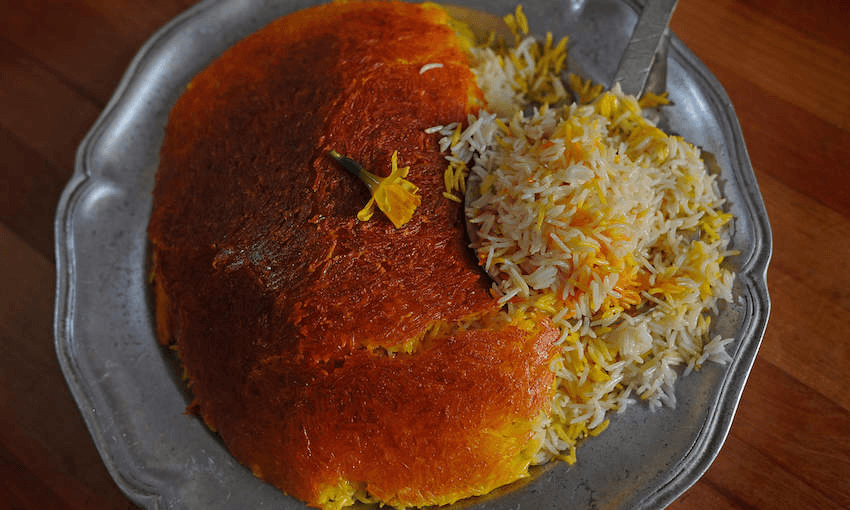Think rice is nothing special? Try tahdig, the golden, crispy rice crust that’s a way of life for Iranians.
As Iranians, we are obsessed with the crunchy bits. The oily, crispy bits. The layers upon layers of starch. True love is at the bottom of a non-stick Persian rice cooker.
Have you always thought of rice as a bland and sticky filler food, there to soak up your stews and curries? Granted, there is a time and place for rice to take a supporting role, but Persian cuisine is not one of those.
The grains of perfectly fluffed, beautifully aromatic long-grained rice (similar to basmati) layered with saffron mean nothing at a dinner party if you haven’t nailed your crispy bottom. Entertaining friends for dinner? Your reputation and your family’s ACTUAL HONOUR depend on how well you’ve cooked your tahdig.
You want your guests to show the right mixture of awe and jealousy at your rice dishes. You want them to talk about it on their way home, and the next day. Tahdig is a way of life. Persian soul food.
Basically, tahdig (pronounced tah-deeg) translates to the bottom of the pot. That beautiful moment when the rice has formed a golden crispy crust but hasn’t burnt. When you’ve nailed the right amount of oil, the right amount of time, the right temperature, type of rice, type of pan – it’s magic, really. A symphony.
You should be able to flip the rice cooker upside down on a platter and have it retain its shape with a masterful, show-stopping flourish. You can make your crust with just rice, or you can get creative with a thin flatbread or sliced potatoes. You can serve it broken up in glorious, irresistible, crispy shards or you can serve it whole and majestic as a centrepiece of the table.
In Iran, rice is the best part of every meal. It’s a talking point at mealtime – where to buy the best rice, how to get the grains to stretch and hold their shape, how to get the most aroma out of the grains.
I’ve heard some say the best rice comes from the rice paddies of Afghanistan, others prefer the northern fields of Iran. Like Iranian politics, nobody ever agrees, but whatever brand of rice you choose, no two grains of your rice should stick together. The long grains should fluff up and stretch, remain intact and emit a beautiful, almost sweet flavour.
If there are any Persians out there living the no-carb life, I salute you, because that’s some serious willpower to walk away from dishes this good.
As important as rice is, tahdig can be made with pasta too. My grandmother makes the world’s best potato tahdig at the bottom of a pile of meaty, juicy, spaghetti oozing with sauce. I know many Italians who might feel more than a little ruffled at this bastardisation of their bolognese, and the overcooking of their noodles, and look, I am truly sorry.
I know what it is like to have your cuisine taken and altered – a splash of rosewater in just about anything and people add the word Persian in front of the recipe. But this pseudo-Italian-Persian dish just tastes so good. It’s true comfort food, and that’s globalisation for you. high
My mum’s specialty is a flavourful rice cake called tahchin. It’s layers of yoghurt- and saffron-infused chicken, fluffy rice and egg yolks to bind it all together. If done right, it sits upright ready to be cut into, the crispy, oily, salty rice crust holding it all together gracefully. Slice this like a birthday cake and serve with a side of salad shirazi and maast-e-khiar and you’re living your best Persian life.
I request this meal every time I visit my parents. And both times I was pregnant, this was one of the few dishes that didn’t make me nauseous. My babies demanded these carbs.
I’ve never once in my life witnessed LEFTOVER tahdig. It is the one dish you can never make enough of. It disappears in minutes, every time.
There are so many recipes online for tahdig that outline the two-step parboiling process that it involves. Instead of going over that, I’ve consulted my most revered experts (the matriarchs of my family) for a few of their top tips on how to get your crispy pan bottoms just right:
- Invest in the right pan. Ideally you need a non-stick rice-cooker direct from Iran – the western or Asian ones won’t cook the rice long enough to make tahdig. My family have jammed countless rice cookers into their checked baggage on trips home from Iran. But the rest of you could try Amazon. Or failing that, a non-stick deep pan with a thick bottom will work too, it might just need a little more attention.
- Find the right rice. Supermarket basmati is OK but ideally you need to visit the more authentic Persian or Indian grocers and ask for their longest grain rice.
- Don’t skimp on the oil. Cover the bottom of the pan or rice cooker well. This isn’t a diet food.
- While there is a bit of improvisation involved in tahdig, just stick to the recipe the first few times while you get a hang of the two-step cooking process.
- Practise, practise, practise. You won’t get this right first time but it’s a skill worth learning. Trust me.

